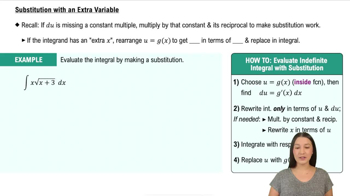108. Arc length Find the length of the curve y = ln(x) on the interval [1, e^2].
Table of contents
- 0. Functions7h 54m
- Introduction to Functions16m
- Piecewise Functions10m
- Properties of Functions9m
- Common Functions1h 8m
- Transformations5m
- Combining Functions27m
- Exponent rules32m
- Exponential Functions28m
- Logarithmic Functions24m
- Properties of Logarithms36m
- Exponential & Logarithmic Equations35m
- Introduction to Trigonometric Functions38m
- Graphs of Trigonometric Functions44m
- Trigonometric Identities47m
- Inverse Trigonometric Functions48m
- 1. Limits and Continuity2h 2m
- 2. Intro to Derivatives1h 33m
- 3. Techniques of Differentiation3h 18m
- 4. Applications of Derivatives2h 38m
- 5. Graphical Applications of Derivatives6h 2m
- 6. Derivatives of Inverse, Exponential, & Logarithmic Functions2h 37m
- 7. Antiderivatives & Indefinite Integrals1h 26m
- 8. Definite Integrals4h 44m
- 9. Graphical Applications of Integrals2h 27m
- 10. Physics Applications of Integrals 3h 16m
- 11. Integrals of Inverse, Exponential, & Logarithmic Functions2h 34m
- 12. Techniques of Integration7h 41m
- 13. Intro to Differential Equations2h 55m
- 14. Sequences & Series5h 36m
- 15. Power Series2h 19m
- 16. Parametric Equations & Polar Coordinates7h 58m
8. Definite Integrals
Introduction to Definite Integrals
Problem 5.5.100b
Textbook Question
Substitutions Suppose ƒ is an even function with ∫₀⁸ ƒ(𝓍) d𝓍 = 9 . Evaluate each integral.
(b) ∫²₋₂ 𝓍²ƒ(𝓍³) d𝓍
 Verified step by step guidance
Verified step by step guidance1
Step 1: Recognize that the integral involves a substitution. The given integral is ∫²₋₂ 𝓍²ƒ(𝓍³) d𝓍. To simplify, let u = 𝓍³. Then, compute the derivative of u with respect to 𝓍: du/d𝓍 = 3𝓍², or equivalently, du = 3𝓍² d𝓍.
Step 2: Rewrite the integral in terms of u. Substitute u = 𝓍³ and du = 3𝓍² d𝓍 into the integral. The integral becomes (1/3) ∫ f(u) du, where the factor of 1/3 comes from the substitution.
Step 3: Adjust the limits of integration. When 𝓍 = -2, u = (-2)³ = -8. When 𝓍 = 2, u = (2)³ = 8. Therefore, the new limits of integration are from u = -8 to u = 8.
Step 4: Use the property of even functions. Since ƒ is an even function, ƒ(u) = ƒ(-u). This allows us to simplify the integral over symmetric limits. Specifically, ∫₋₈⁸ ƒ(u) du = 2 ∫₀⁸ ƒ(u) du.
Step 5: Substitute the given value of ∫₀⁸ ƒ(𝓍) d𝓍 = 9 into the equation. The integral becomes (1/3) * 2 * 9. Simplify this expression to find the final result.
 Verified video answer for a similar problem:
Verified video answer for a similar problem:This video solution was recommended by our tutors as helpful for the problem above
Video duration:
4mPlay a video:
Was this helpful?
Key Concepts
Here are the essential concepts you must grasp in order to answer the question correctly.
Even Functions
An even function is defined by the property that ƒ(−x) = ƒ(x) for all x in its domain. This symmetry about the y-axis implies that the area under the curve from -a to a is twice the area from 0 to a. Understanding this property is crucial for evaluating integrals involving even functions, as it simplifies calculations and allows for the use of symmetry.
Recommended video:

Exponential Functions
Substitution in Integration
Substitution is a technique used in integration to simplify the process by changing the variable of integration. It involves selecting a new variable, often denoted as u, which is a function of x, and transforming the integral accordingly. This method is particularly useful when dealing with composite functions, as it can make the integral more manageable and easier to solve.
Recommended video:

Substitution With an Extra Variable
Definite Integrals
A definite integral represents the signed area under a curve between two specified limits, a and b. It is denoted as ∫ₐᵇ ƒ(x) dx and provides a numerical value that reflects the accumulation of quantities, such as area or volume. Understanding the properties of definite integrals, including their evaluation and the Fundamental Theorem of Calculus, is essential for solving problems involving area calculations and function analysis.
Recommended video:

Definition of the Definite Integral

 5:43m
5:43mWatch next
Master Definition of the Definite Integral with a bite sized video explanation from Patrick
Start learningRelated Videos
Related Practice
Textbook Question
34
views
